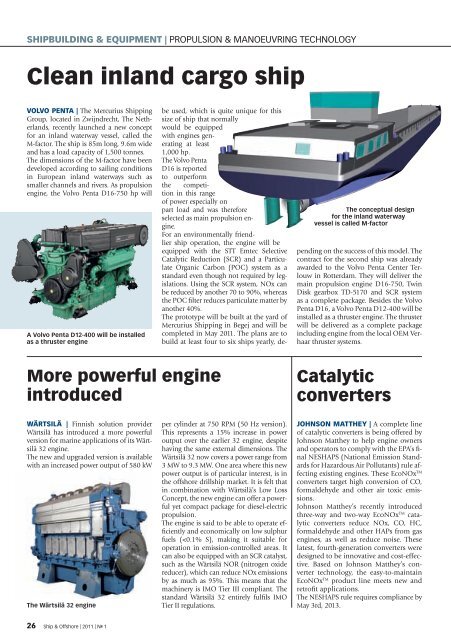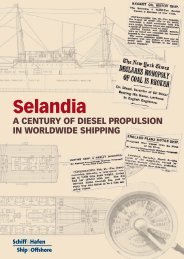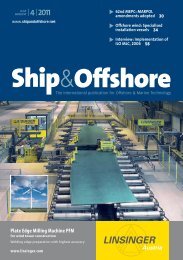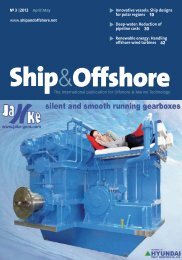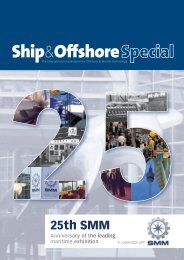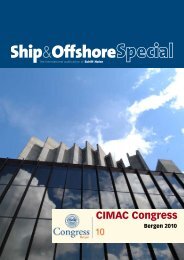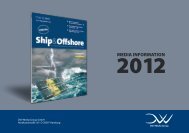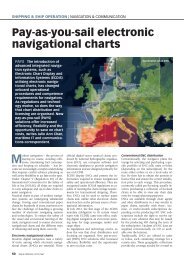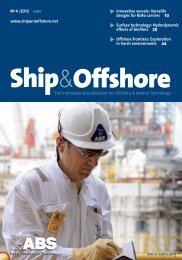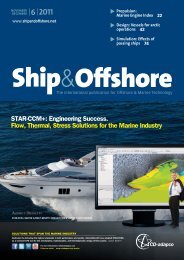Arctic technology: Winterisation of FPSO 38 Cruise ... - Ship & Offshore
Arctic technology: Winterisation of FPSO 38 Cruise ... - Ship & Offshore
Arctic technology: Winterisation of FPSO 38 Cruise ... - Ship & Offshore
Create successful ePaper yourself
Turn your PDF publications into a flip-book with our unique Google optimized e-Paper software.
SHIPBUILDING & EQUIPMENT | PROPULSION & MANOEUVRING TECHNOLOGY<br />
Clean inland cargo ship<br />
VOLVO PENTA | The Mercurius <strong>Ship</strong>ping<br />
Group, located in Zwijndrecht, The Netherlands,<br />
recently launched a new concept<br />
for an inland waterway vessel, called the<br />
M-factor. The ship is 85m long, 9.6m wide<br />
and has a load capacity <strong>of</strong> 1,500 tonnes.<br />
The dimensions <strong>of</strong> the M-factor have been<br />
developed according to sailing conditions<br />
in European inland waterways such as<br />
smaller channels and rivers. As propulsion<br />
engine, the Volvo Penta D16-750 hp will<br />
A Volvo Penta D12-400 will be installed<br />
as a thruster engine<br />
More powerful engine<br />
introduced<br />
WÄRTSILÄ | Finnish solution provider<br />
Wärtsilä has introduced a more powerful<br />
version for marine applications <strong>of</strong> its Wärtsilä<br />
32 engine.<br />
The new and upgraded version is available<br />
with an increased power output <strong>of</strong> 580 kW<br />
The Wärtsilä 32 engine<br />
26 <strong>Ship</strong> & <strong>Offshore</strong> | 2011 | N o 1<br />
be used, which is quite unique for this<br />
size <strong>of</strong> ship that normally<br />
would be equipped<br />
with engines generating<br />
at least<br />
1,000 hp.<br />
The Volvo Penta<br />
D16 is reported<br />
to outperform<br />
the competition<br />
in this range<br />
<strong>of</strong> power especially on<br />
part load and was therefore<br />
selected as main propulsion engine.<br />
For an environmentally friendlier<br />
ship operation, the engine will be<br />
equipped with the STT Emtec Selective<br />
Catalytic Reduction (SCR) and a Particulate<br />
Organic Carbon (POC) system as a<br />
standard even though not required by legislations.<br />
Using the SCR system, NOx can<br />
be reduced by another 70 to 90%, whereas<br />
the POC fi lter reduces particulate matter by<br />
another 40%.<br />
The prototype will be built at the yard <strong>of</strong><br />
Mercurius <strong>Ship</strong>ping in Begej and will be<br />
completed in May 2011. The plans are to<br />
build at least four to six ships yearly, de-<br />
per cylinder at 750 RPM (50 Hz version).<br />
This represents a 15% increase in power<br />
output over the earlier 32 engine, despite<br />
having the same external dimensions. The<br />
Wärtsilä 32 now covers a power range from<br />
3 MW to 9.3 MW. One area where this new<br />
power output is <strong>of</strong> particular interest, is in<br />
the <strong>of</strong>fshore drillship market. It is felt that<br />
in combination with Wärtsilä’s Low Loss<br />
Concept, the new engine can <strong>of</strong>fer a powerful<br />
yet compact package for diesel-electric<br />
propulsion.<br />
The engine is said to be able to operate effi<br />
ciently and economically on low sulphur<br />
fuels (


